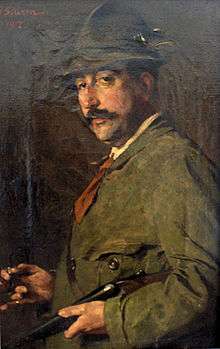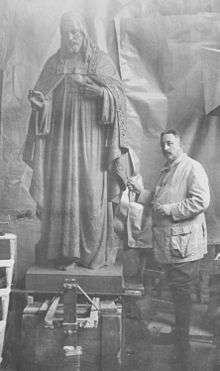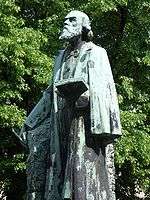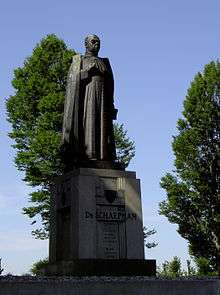August Falise
Augustinus Franciscus Henri Falise (26 January 1875 in Wageningen – 7 January 1936) was a Dutch sculptor and medailleur (minter of medals).[1][2] Next to smaller sculptures he designed large monuments of public figures in stone or messing which are still present in many towns in the Netherlands.
August Falise | |
|---|---|
 August Falise; Painting by Georg Sturm, 1917 | |
| Born | Augustinus Franciscus Henri Falise 26 January 1875 Wageningen, Netherlands |
| Died | 6 January 1936 (aged 60) Wageningen, Netherlands |
| Nationality | Dutch |
| Education | Rijksakademie |
| Known for | sculpting |
Biography
Falise descended from a French/Belgian family of plasterers that had settled in Wageningen. He was a teacher of anatomic drawings and modelling at the AKV St. Joost in 's-Hertogenbosch. In 1912 he moved in Wageningen into the house Antonia. The street where he lived, was partially renamed in 1941 to August Faliseweg. He was married to Antoinette Hof; the marriage was childless. Falise won many prizes and received Dutch and international awards. In 1936 the award of the Order of St. Gregory the Great and the Belgium Order of the Crown (Belgium).
Exhibitions
The Museum De Casteelse Poort in Wageningen organized an exhibition about August Falise from 18 June 2010 until 20 February 2011.[3][4] This exhibition attracted substantial regional media attention and led to renewed interest in the once famous Dutch sculptor.
Work

Statues that can be seen in public space:
- 1910 – Johann Georg Mezger, 't Groentje, Domburg
- 1911 – Johan van Oldenbarnevelt, Stationsplein, Amersfoort, in 1933 verplaatst naar de tuin van het Stedelijk Gymnasium Johan van Oldenbarnevelt
- 1919 – Lodewijk Thomson, Groningen, since 2003 a replica in Durres, Albania; second replica since 28 June 2014 in the Senate building at the Binnenhof in the Hague
- 1921 – Heilig Hartbeeld, Keulsepoort, Venlo
- 1926 – Thomas Aquinas, Comeniuslaan (bij aula Radboud Universiteit); 1946: Wilhelminasingel, Nijmegen (onthulling 1 juni 1926)
- 1926 – De Zaaier (The Sower), Herenstraat, Wageningen (unveiled 14 September 1926; moved to Costerweg in 1990, and to Droevendaalsesteeg in 2012)
- 1927 – Dr. Herman Schaepman, Es, Tubbergen (onthulling 11 augustus 1927)
- 1927 – Mr. Wiardus Willem van Haersma Buma, Emmen (onthulling 5 oktober 1927)
- 1928 – Willem Emmens, tegen over Hoofdstraat 29, Zeijen. (onthulling mei 1929 te Emmen
- 1929 – Jan Morks, Molenwater, Middelburg (onthulling 20 augustus 1929)
- 1930 – P.J.H. Cuypers, Munsterkerk, Roermond (onthulling 10 juni 1930)
- 1930 – Hieronymus Bosch, Markt, 's-Hertogenbosch (onthulling 17 juni 1930)
- 1933 – Borstbeeld van Joannes Benedictus van Heutsz in Coevorden (onthulling 8 juli 1933 door prins-gemaal Prince Henry, Duke of Mecklenburg-Schwerin)
- 1934 – Dr. Alfons Ariëns, Ariënsplein, Enschede (onthulling 16 juni 1934)
- 1934 – Kardinaal Van Rossum, Kardinaal van Rossumplein, 's-Hertogenbosch (onthulling 24 juni 1934)
Source: www.vanderkrogt.net[5]
Gallery
- Jeroen Bosch
('s-Hertogenbosch) - Bosboom-Toussaint, 1912
(Alkmaar)  Johan van Oldenbarnevelt
Johan van Oldenbarnevelt
(Amersfoort)- Clément van Maasdijk
(Arnhem) - Christus Heilig Hart, 1926
(Breda)  Lodewijk Thomson
Lodewijk Thomson
(Groningen)- Christus Heilig Hart
(Oosterbeek)  Statue Pierre Cuypers
Statue Pierre Cuypers
(Roermond)_van_August_Falise.jpg) Christus Heilig Hart
Christus Heilig Hart
(Sappermeer) Dr. Herman Schaepman
Dr. Herman Schaepman
(Tubbergen) De zaaier
De zaaier
(Wageningen) Monument Vrijwillige Landstorm (Rhenen); replica by Roel van der Burg of sculpture destroyed in World War II
Monument Vrijwillige Landstorm (Rhenen); replica by Roel van der Burg of sculpture destroyed in World War II
References
- "August Falise (1875–1936)" (in Dutch). Galeries.nl. Retrieved 9 November 2012.
- "Falise, August" (in Dutch). Rijksbureau voor Kunsthistorische Documentatie. Retrieved 9 November 2012.
- "Tentoonstelling over beeldhouwer August Falise" (in Dutch). Historiek.net. 28 June 2010. Archived from the original on 22 February 2013. Retrieved 9 November 2012.
- "Expositie: August Falise (1875–1936)". Museum De Casteelse Poort. Archived from the original on 22 February 2013. Retrieved 9 November 2012.
- "Statues: August Falise". vanderkrogt.net. Retrieved 9 November 2012.
Further reading
- Leerboek der anatomie, beschrijving van het geraamte, de spieren en de proportie van het menschelijk lichaam, ten dienste van het middelbaar onderwijs, van kunstacademies en van hen die zich bekwamen voor de kunstnijverheidacten door August Falise, beeldhouwer, met daarbij: anatomische atlas, inhoudende dertig bladen met afbeeldingen van het geraamte, de spieren en de proportie van het menschelijk lichaam, teekeningen van L. P. Cruyff, Arnhem, 1923, N.V. v.h. Kluppell & Ebeling.
- A.G. Steenbergen, Kent u ze nog ... de Wageningers, Europese Bibliotheek, Zaltbommel, 1973
- A.G. Steenbergen, "August Falise 50 jaar geleden gestorven", in: Mededelingen van de Historische Vereniging "Oud Wageningen", 14 (1986) nr. 2, p. 25
- P. Thoben, "August Falise. De beeldhouwer, 1875–1936", in: Mededelingen van de Historische Vereniging "Oud Wageningen", 14 (1986) nr. 3, p. 42
- G.J.A. Hamilton, "August Falise, 1875–1936, beeldhouwer", in: Biografisch Woordenboek Gelderland, deel 9, p. 48–51, 2012, ISBN 978-90-8704-321-6
External links
| Wikimedia Commons has media related to August Falise. |